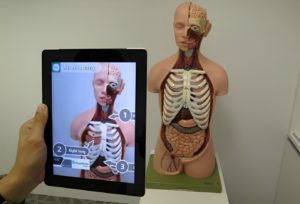Augmented Reality in Libraries
05 June 2023
What is augmented reality?
Augmented reality (AR) is the integration of digital information with the user’s environment in real time. Unlike virtual reality (VR), which creates an artificial environment, AR users experience a real-world environment with generated perceptual information overlaid on top of it.
Why is it popular and trending?
AR gained global fame with the release of the Pokémon Go game in 2016. This technology enables users to see and interact with virtual objects and information seamlessly, as if they were part of the real world. By overlaying images and text onto the user’s view of the natural world or anchoring virtual objects to real-world locations, AR provides captivating and immersive experiences. It has found applications in interactive museum exhibits, mobile games utilising real-world locations, and training simulations.
How can AR be utilised in libraries?
AR technology can enhance libraries by providing interactive displays that offer additional information and multimedia content related to library collections. For example, an AR display in a library exhibit on the history of a city can allow users to view virtual reconstructions of historical buildings. AR can also facilitate access to supplementary multimedia content related to specific e-books or articles. Additionally, AR can offer interactive tours of libraries, virtual maps showcasing the locations of different collections and resources, educational games, quizzes, and even act as a virtual assistant or chatbot, allowing users to ask questions and receive real-time answers.
Where and how has AR been used in libraries?
Various libraries have embraced AR to create engaging and interactive experiences for their visitors. For instance:
- The University of Maryland Libraries in College Park, Maryland, USA, used AR to create interactive exhibits and displays that provide additional information and multimedia content related to library collections.
- The University of California, San Diego (UCSD) Libraries in San Diego, California, USA, used AR to create interactive library tours for students that allow users to explore the library’s collections and resources in a fully immersive environment.
- The National Library of Medicine in Bethesda, Maryland, USA, used AR to create interactive exhibits and displays that provide additional information and multimedia content related to library collections, such as the History of Medicine Division’s “Doorway to the Past” exhibit, which uses AR to provide additional context and information about historical medical artefacts.
- The National Library of Korea in Seoul, South Korea, used AR to create interactive exhibits and displays that provide additional information and multimedia content related to library collections and exhibitions, such as the “History of Korean Medicine” exhibit, which uses AR to provide further information.
- The National Library of Sweden in Stockholm, Sweden, used AR to create interactive exhibits and displays that provide additional information and multimedia content related to library collections and exhibitions, such as the “Treasures of the National Library” exhibit, which uses AR to provide further context and information about rare and unique library items.
How can AR benefit medical libraries?
In medical libraries, AR can revolutionise the way medical concepts are visualised and understood. It can provide interactive 3D models of anatomy and medical procedures, enabling medical students and professionals to engage with complex topics more effectively. AR can also streamline access to information about medical resources by allowing users to simply point their devices at specific book or journal covers, instantly retrieving relevant information. Furthermore, AR can offer real-time guidance during medical procedures, projecting vital information onto a patient’s body, such as the location of veins or other critical structures. Medical libraries can also utilise AR to create interactive exhibits, showcasing medical instruments or simulating medical procedures, thereby enhancing user engagement and providing a more immersive experience.
Limitations of AR
Implementing AR in libraries may face challenges such as the cost of the technology, device compatibility, technical expertise of staff, and user adoption of unfamiliar applications. Overcoming these hurdles will be crucial for successful integration.
The Future of Libraries with AR and ChatGPT
The combination of AR and ChatGPT technologies holds exciting potential for enhancing user experiences. Integrating chatbots into AR apps can provide personalised and engaging interactions with virtual objects, while utilising visual cues can make interactions with digital avatars more natural and enjoyable. As AR and chatbot technologies continue to advance, we can anticipate a future where libraries incorporate these technologies to create dynamic and immersive experiences for users.
While AR is still relatively new in the library domain, the rapid pace of technological advancement suggests that the implementation of AR in libraries will continue to accelerate, ushering in a new era of engaging and interactive library experiences.
Let us embrace this digital wave and look forward to the exciting possibilities that AR can bring to libraries.


Contributed by Ellora Barman, Librarian, Central Library, All India Institute of Medical Sciences.